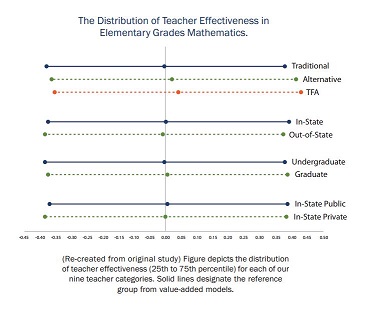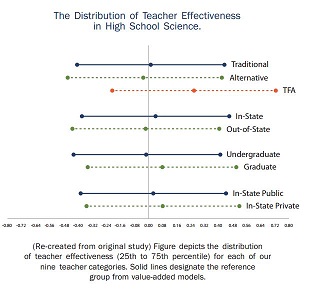Over the
years, there have been a gazillion studies examining the relative merit of
different pathways into the teaching profession. Almost all come up short,
often because the studies do not clearly define the type of pathway being
analyzed (i.e., just what does it mean to be alternatively certified?)
A new study from Gary T. Henry and his colleagues at Vanderbilt does not
disappoint, breaking down the
definitions of assorted pathways into more meaningful categories as well as
examining the results of only new teachers (those with less than three years of
experience). After all, should we really judge a preparation program by the
teachers who graduated from Ol’ State U. in 1980 or by those who graduated in
2014?
Henry et al. disaggregate teaching
pathways into multiple distinct categories: out of state, in state, graduate,
undergraduate, public, private, Teach
For America and lateral entry (North
Carolina‘s own alternative entry).
As always, the researchers find more
variation within the groups than across; there are some notable differences in
this study from what previous research has found.
 There is
There is
some limited evidence of a “home team” advantage for specific teachers; teachers who were prepared in-state
were more effective than those from out-of-state programs in three of the eight subjects tested. Additionally, teachers prepared in private
institutions were no better than those from public institutions, a finding
we didn’t find surprising given that we haven’t found a discernible difference
between the two in the Teacher Prep Review.
One takeaway
consistent with other studies’ findings: TFA
comes out looking great. Students instructed by TFAcorps members annually gain approximately 18 days of additional
learning in elementary math, 11 days in elementary reading and an astounding 73
days in middle grade math.
While there
aren’t many TFA corps members in North Carolina, other alternatively
trained teachers (referred to as “lateral entry”) have a much harder time
posting gains. Findings conclude they are less effective (especially in STEM
subjects) or, at best, average.

Here’s a finding
we’ve never seen before: in both middle
grade math and reading, teachers trained in graduate school aren’t as effective
as teachers trained as undergraduates— though they do better in high school
science. This needs more research to figure out if those different outcomes are
due to the focus of masters’ degrees, if they were content specific, or in
education.
More like this

National Council on Teacher Quality opposes the executive order to dismantle the Department of Education

Black History Month: Learning to read is a civil right

As seasons change, one thing remains the same: The persistent lack of diversity in the teacher workforce


